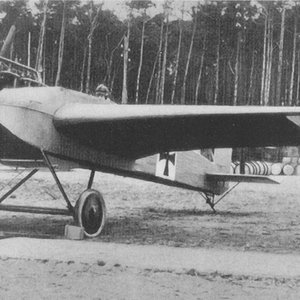Navigation
Install the app
How to install the app on iOS
Follow along with the video below to see how to install our site as a web app on your home screen.
Note: This feature may not be available in some browsers.
More options
You are using an out of date browser. It may not display this or other websites correctly.
You should upgrade or use an alternative browser.
You should upgrade or use an alternative browser.
Junkers J 1
Junkers J 1 all metal "technology demonstrator" pioneer aircraft, at FEA 1, Döberitz, Germany in late 1915, undergoing flight preparations
Date Late 1915
The Junkers J 1, nicknamed the Blechesel ("Tin Donkey" or "Sheet Metal Donkey"), was the world's first practical all-metal aircraft. Built early in World War I, when aircraft designers relied largely on fabric-covered wooden structures, the Junkers J 1 was a revolutionary development in aircraft design, being built and flown only 12 years after the Wright Brothers had first flown the "Flyer I" biplane in December 1903. This experimental aircraft never received an official "E-series" monoplane designation from IdFlieg and the Luftstreitkräfte, probably because it was primarily intended as a practical demonstration of Junkers' metal-based structural ideas, and was officially only known by its Junkers factory model number of J 1. It should not be confused with the later, armoured all-metal Junkers J 4 sesquiplane, accepted by the Luftstreitkräfte as the Junkers J.I, using a Roman numeral)
Junkers J 1 all metal "technology demonstrator" pioneer aircraft, at FEA 1, Döberitz, Germany in late 1915, undergoing flight preparations
Date Late 1915
The Junkers J 1, nicknamed the Blechesel ("Tin Donkey" or "Sheet Metal Donkey"), was the world's first practical all-metal aircraft. Built early in World War I, when aircraft designers relied largely on fabric-covered wooden structures, the Junkers J 1 was a revolutionary development in aircraft design, being built and flown only 12 years after the Wright Brothers had first flown the "Flyer I" biplane in December 1903. This experimental aircraft never received an official "E-series" monoplane designation from IdFlieg and the Luftstreitkräfte, probably because it was primarily intended as a practical demonstration of Junkers' metal-based structural ideas, and was officially only known by its Junkers factory model number of J 1. It should not be confused with the later, armoured all-metal Junkers J 4 sesquiplane, accepted by the Luftstreitkräfte as the Junkers J.I, using a Roman numeral)








